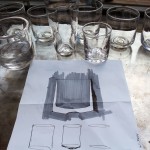The GlassLab design program offers designers unprecedented access to molten glass. In public design performances or private sessions, designers and glassmakers collaborate, rapidly prototyping concepts and using the immediacy of hot glass as a catalyst for innovation.
Last week, designer Bridget Sheehan, a recent MFA graduate, worked with glassmakers to prototype her designs here at the Museum as the recipient of the 2014 GlassLab Fellowship.
- 2014 GlassLab Fellowship recipient Bridget Sheehan
- Designer Bridget Sheehan at GlassLab
- Design by GlassLab Fellowship recipient Bridget Sheehan
Now in it’s second year, the GlassLab Fellowship is awarded annually to a Rochester Institute of Technology (RIT) Industrial Design student providing them the opportunity to participate in a two-day GlassLab session at the Museum.
I caught up with Bridget to ask a few questions about the experience.
How did you approach this design project for the GlassLab Fellowship?
I approached this project much like I approach most of my design projects. I began by researching what glass can do and how it acts as a material, paying close attention to my interaction with objects made of glass in daily life.
After bouncing ideas off of my professors, classmates, and friends it became evident that what I needed to design was something I had a passion for, so I pulled out a stack of paper and began sketching ideas around the subject of drinking glasses. Specifically, I began designing glasses for whiskey and beer that would allow the user to swirl their beverages as their glass remains in contact with the table.
Have you worked with glass as a material before? What did you expect?
I hadn’t worked with glass as a material prior to GlassLab, although I was familiar with the process and capabilities of glassblowing prior to being awarded this Fellowship. I went to GlassLab with two very specific designs and expected to walk away with a few prototypes that demonstrated the intent of my designs, and I think I did just that. My design is simple in form, but due to the nature of the materials I had a hunch that it would be a challenge for the gaffers to create―particularly without a mold. The gaffers I worked with very quickly understood my design intent and set out to make my designs a reality.
Through a bit of trial and error, they were able to develop a process that resulted in prototypes that very clearly demonstrated what I set out to do with my designs.
What is the most significant thing that you learned working with glass for this project?
Looking back, it is clear that prior to this experience I hadn’t thought about the capabilities of glass. Though I designed drinking glasses, which are among the more prominent glass objects, I now recognize the immense opportunities that glass offers designers. I look forward to embracing the use of glass as a material more as my design career develops.
Sheehan is currently working full-time as a craftsman at designer Wendell Castle’s studio in Scottsville, NY and will start as an Adjunct Professor for RIT’s School of Design this coming fall. See more of her designs at http://bridgetdsheehan.com and learn more about GlassLab at www.cmog.org/glasslab.






